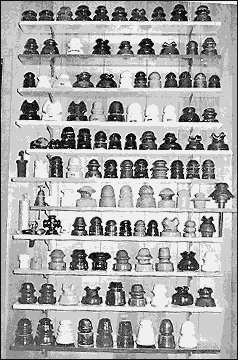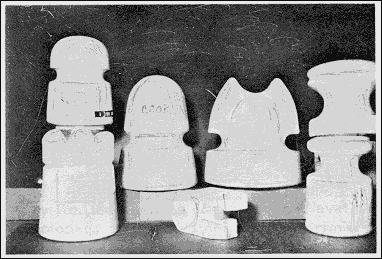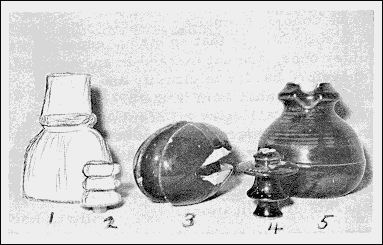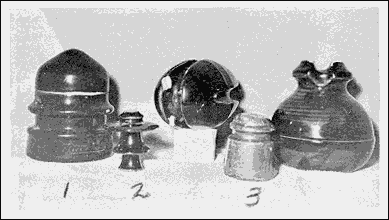Collecting Ceramic Insulators
by Gerald Brown
Reprinted from "INSULATORS - Crown Jewels of the Wire", January 1970, page 3
The ceramic (pottery) part of our insulator collection is really castoffs.
Although the first
of the collection was two pottery insulators, the collecting was primarily
concerned with
glass; the pottery ones were saved but sort of relegated to the background.
However, there came the time when there were so many pretty and interesting
ones, that
the pottery ones were displayed and more attention was paid to that part of
the collection.
Because Esta was so engrossed with glass insulators, I fell heir to the
ceramics. Because
I have been interested in the old and historic insulators, emphasis has
been on that kind.
However, all kinds have been saved, until now the collection numbers about
200 different
kinds. These are all small line type, not large power types.
The picture shown on the next page is a display which is about one half of
the collection.
It will be noted that one shelf shows mica and composition insulators.
These and rubber,
iron, plastic and wooden insulators have been included in the collection.
It seems that
these types fit better with the pottery than with the glass. Also the
rams-horns go better
with this collection. Some of these are shown in the picture.
All manner of pottery "things'' which have to do with wiring, telephone and
telegraph lines
have been included in the collection. I call these "go-withs". There are
several dozen
small fence insulators, knobs, wall tubes, strain insulators, etc. in the
collection. I have
mounted most of these on wall plaques made of peg board.
These display boards cannot be changed, but I find it interesting
to change the shelf displays. This makes it more interesting for
me, as well as for visitors.

Many of these insulators have been obtained from other
collectors by trading, and I have found that almost all antique
stores have a few pottery insulators around, and many have been purchase. They
are generally cheaper than glass ones.


1. White Ceramic from Australia
2. White knob P. P.
3. Brown Ceramic Strain insulator
4. Thomas High Voltage (miniature salesman sample?)
5. Fog bowl

1. Dry splice insulator
3. Old Locke pony
There are not so many collectors who are as
enthusiastic about the ceramics, but I think it
is just as rewarding as the glass and can certainly be done on a smaller budget.
One drawback to collecting is that so many, especially of
the older ones, are not marked in any way and
are therefore harder to classify and identify.
At the present time I am in the process of
sketching and cataloging all of mine. I am numbering mine, and it may be that
some collector
or several can come up with some method of
classifying that would become universal. I put
the branded ones, such as Locke, Pincos, etc.
in separate classifications.
Whether these insulators are classified or not,
I think they can be collected and displayed, and
the collection will give a lot of pleasure.
| 